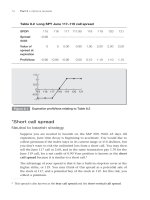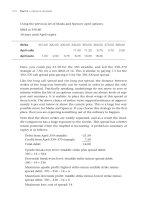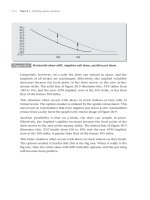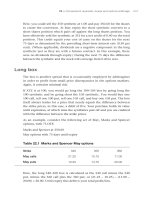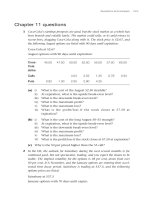CWNA guide to wireless LANs 2nd ch03
Bạn đang xem bản rút gọn của tài liệu. Xem và tải ngay bản đầy đủ của tài liệu tại đây (737.36 KB, 52 trang )
CWNA Guide to Wireless
LANs, Second Edition
Chapter Three
How Wireless Works
Objectives
• Explain the principals of radio wave transmissions
• Describe RF loss and gain, and how it can be
measured
• List some of the characteristics of RF antenna
transmissions
• Describe the different types of antennas
CWNA Guide to Wireless LANs, Second Edit
2
Radio Wave Transmission Principles
• Understanding principles of radio wave
transmission is important for:
– Troubleshooting wireless LANs
– Creating a context for understanding wireless
terminology
CWNA Guide to Wireless LANs, Second Edit
3
What Are Radio Waves?
• Electromagnetic wave: Travels freely through
space in all directions at speed of light
• Radio wave: When electric current passes through
a wire it creates a magnetic field around the wire
– As magnetic field radiates, creates an
electromagnetic radio wave
• Spreads out through space in all directions
– Can travel long distances
– Can penetrate non-metallic objects
CWNA Guide to Wireless LANs, Second Edit
4
What Are Radio Waves? (continued)
Table 3-1: Comparison of wave characteristics
CWNA Guide to Wireless LANs, Second Edit
5
Analog vs. Digital Transmissions
Figure 3-2: Analog signal
Figure 3-4: Digital signal
CWNA Guide to Wireless LANs, Second Edit
6
Analog vs. Digital Transmissions
(continued)
• Analog signals are continuous
• Digital signals are discrete
• Modem (MOdulator/DEModulator): Used when
digital signals must be transmitted over analog
medium
– On originating end, converts distinct digital signals
into continuous analog signal for transmission
– On receiving end, reverse process performed
• WLANs use digital transmissions
CWNA Guide to Wireless LANs, Second Edit
7
Frequency
Figure 3-5: Long waves
Figure 3-6: Short Waves
CWNA Guide to Wireless LANs, Second Edit
8
Frequency (continued)
• Frequency: Rate at which an event occurs
• Cycle: Changing event that creates different radio
frequencies
– When wave completes trip and returns back to
starting point it has finished one cycle
• Hertz (Hz): Cycles per second
– Kilohertz (KHz) = thousand hertz
– Megahertz (MHz) = million hertz
– Gigahertz (GHz) = billion hertz
CWNA Guide to Wireless LANs, Second Edit
9
Frequency (continued)
Figure 3-7: Sine wave
CWNA Guide to Wireless LANs, Second Edit
10
Frequency (continued)
Table 3-2: Electrical terminology
CWNA Guide to Wireless LANs, Second Edit
11
Frequency (continued)
• Frequency of radio wave can be changed by
modifying voltage
• Radio transmissions send a carrier signal
– Increasing voltage will change frequency of carrier
signal
CWNA Guide to Wireless LANs, Second Edit
12
Frequency (continued)
Figure 3-8: Lower and higher frequencies
CWNA Guide to Wireless LANs, Second Edit
13
Modulation
• Carrier signal is a continuous electrical signal
– Carries no information
• Three types of modulations enable carrier signals
to carry information
– Height of signal
– Frequency of signal
– Relative starting point
• Modulation can be done on analog or digital
transmissions
CWNA Guide to Wireless LANs, Second Edit
14
Analog Modulation
• Amplitude: Height of carrier wave
• Amplitude modulation (AM): Changes amplitude
so that highest peaks of carrier wave represent 1
bit while lower waves represent 0 bit
• Frequency modulation (FM): Changes number of
waves representing one cycle
– Number of waves to represent 1 bit more than
number of waves to represent 0 bit
• Phase modulation (PM): Changes starting point of
cycle
– When bits change from 1 to 0 bit or vice versa
CWNA Guide to Wireless LANs, Second Edit
15
Analog Modulation (continued)
Figure 3-9: Amplitude
CWNA Guide to Wireless LANs, Second Edit
16
Analog Modulation (continued)
Figure 3-10: Amplitude modulation (AM)
CWNA Guide to Wireless LANs, Second Edit
17
Analog Modulation (continued)
Figure 3-11: Frequency modulation (FM)
CWNA Guide to Wireless LANs, Second Edit
18
Analog Modulation (continued)
Figure 3-12: Phase modulation (PM)
CWNA Guide to Wireless LANs, Second Edit
19
Digital Modulation
• Advantages over analog modulation:
–
–
–
–
Better use of bandwidth
Requires less power
Better handling of interference from other signals
Error-correcting techniques more compatible with
other digital systems
• Unlike analog modulation, changes occur in
discrete steps using binary signals
– Uses same three basic types of modulation as
analog
CWNA Guide to Wireless LANs, Second Edit
20
Digital Modulation (continued)
Figure 3-13: Amplitude shift keying (ASK)
CWNA Guide to Wireless LANs, Second Edit
21
Digital Modulation (continued)
Figure 3-14: Frequency shift keying (FSK)
CWNA Guide to Wireless LANs, Second Edit
22
Digital Modulation (continued)
Figure 3-15: Phase shift keying (PSK)
CWNA Guide to Wireless LANs, Second Edit
23
Radio Frequency Behavior: Gain
• Gain: Positive difference in amplitude between two
signals
– Achieved by amplification of signal
– Technically, gain is measure of amplification
– Can occur intentionally from external power source
that amplifies signal
– Can occur unintentionally when RF signal bounces
off an object and combines with original signal to
amplify it
CWNA Guide to Wireless LANs, Second Edit
24
Radio Frequency Behavior: Gain
(continued)
Figure 3-16: Gain
CWNA Guide to Wireless LANs, Second Edit
25




